Analysis of Land Use Change and Expansion of Surface Urban Heat Island in Bogor City by Remote Sensing
Abstract
:1. Introduction
2. Materials and Methods
2.1. Study Area and Materials
2.2. Local Climate Zone (LCZ)
2.3. Data Post-Processing and Accuracy Assessment of LCZ Classification
2.4. Normalized Difference Vegetation Index (NDVI)
2.5. Derivation of Land Surface Temperature (LST)
2.6. Urban Change Degree and UHI Development
3. Results and Discussion
3.1. Accuracy Evaluation of LCZ
3.2. LCZ Characteristics
3.3. City Expansion
3.4. LST Characteristics and LCZ Type
3.5. Relationship between LST and NDVI
3.6. UHI Expansion and Urban Change Degree
3.7. High Change Area
4. Conclusions
Author Contributions
Acknowledgments
Conflicts of Interest
References
- Voogt, J.A.; Oke, T.R. Thermal remote sensing of urban climates. Remote Sens. Environ. 2003, 86, 370–384. [Google Scholar] [CrossRef]
- Streutker, D.R. A remote sensing study of the urban heat island of Houston, Texas. Int. J. Remote Sens. 2002, 23, 2595–2608. [Google Scholar] [CrossRef]
- Roth, M.; Oke, T.R.; Emery, W.J. Satellite-derived urban heat islands from three coastal cities and the utilization of such data in urban climatology. Int. J. Remote Sens. 1989, 37–41. [Google Scholar] [CrossRef]
- Estoque, R.C.; Murayama, Y.; Myint, S.W. Effects of landscape composition and pattern on land surface temperature: An urban heat island study in the megacities of Southeast Asia. Sci. Total Environ. 2017, 577, 349–359. [Google Scholar] [CrossRef] [PubMed]
- Yuan, F.; Bauer, M.E. Comparison of impervious surface area and normalized difference vegetation index as indicators of surface urban heat island effects in Landsat imagery. Remote Sens. Environ. 2007, 106, 375–386. [Google Scholar] [CrossRef]
- Dousset, B.; Gourmelon, F. Satellite multi-sensor data analysis of urban surface temperatures and landcover. ISPRS J. Photogram. Remote Sens. 2003, 58, 43–54. [Google Scholar] [CrossRef]
- Chen, X.L.; Zhao, H.M.; Li, P.X.; Yin, Z.Y. Remote sensing image-based analysis of the relationship between urban heat island and land use/cover changes. Remote Sens. Environ. 2006, 104, 133–146. [Google Scholar] [CrossRef]
- Rhee, J.; Park, S.; Lu, Z. Relationship between land cover patterns and surface temperature in urban areas. GISci. Remote Sens. 2014, 51, 521. [Google Scholar] [CrossRef]
- Liu, L.; Zhang, Y. Urban Heat Island Analysis Using the Landsat TM Data and ASTER Data: A Case Study in Hong Kong. Remote Sens. 2011, 1535–1552. [Google Scholar] [CrossRef]
- Zhang, X.; Estoque, R.C.; Murayama, Y. An urban heat island study in Nanchang City, China based on land surface temperature and social-ecological variables. Sustain. Cities Soc. 2017, 32, 557–568. [Google Scholar] [CrossRef]
- Wang, H.; Zhang, Y.; Tsou, J.; Li, Y. Surface Urban Heat Island Analysis of Shanghai (China) Based on the Change of Land Use and Land Cover. Sustainability 2017, 9, 1538. [Google Scholar] [CrossRef]
- Liu, W.; Feddema, J.; Hu, L.; Zung, A.; Brunsell, N. Seasonal and diurnal characteristics of land surface temperature and major explanatory factors in Harris County, Texas. Sustainability 2017, 9. [Google Scholar] [CrossRef]
- Weng, Q.; Lu, D.; Schubring, J. Estimation of land surface temperature-vegetation abundance relationship for urban heat island studies. Remote Sens. Environ. 2004, 89, 467–483. [Google Scholar] [CrossRef]
- Connors, J.P.; Galletti, C.S.; Chow, W.T.L. Landscape configuration and urban heat island effects: Assessing the relationship between landscape characteristics and land surface temperature in Phoenix, Arizona. Landsc. Ecol. 2013, 28, 271–283. [Google Scholar] [CrossRef]
- Chen, X.; Zhang, Y. Impacts of urban surface characteristics on spatiotemporal pattern of land surface temperature in Kunming of China. Sustain. Cities Soc. 2017, 32, 87–99. [Google Scholar] [CrossRef]
- Stewart, I.D.; Oke, T.R. Local climate zones for urban temperature studies. Bull. Am. Meteorol. Soc. 2012, 93, 1879–1900. [Google Scholar] [CrossRef]
- Bechtel, B.; Foley, M.; Mills, G.; Ching, J.; See, L.; Alexander, P.; Gál, T. CENSUS of Cities: LCZ Classification of Cities (Level 0)—Workflow and Initial Results from Various Cities. In Proceedings of the 9th International Conference on Urban Climate jointly with 12th Symposium on the Urban Environment, Toulouse, France, 20–24 July 2015. [Google Scholar] [CrossRef]
- BPS-Statistics of Bogor City. (2015). Bogor City in Figures. Bogor City: Statistics of Bogor City, Indonesia. Available online: https://www.westjavainc.org/wp-content/uploads/2016/04/Kota-Bogor-Dalam-Angka-2015.pdf (accessed on 19 August 2017).
- BPS-Statistics of Bogor City. (2016). Bogor City in Figures. Bogor City: Statistics of Bogor City, Indonesia. Available online: http://bappeda.kotabogor.go.id/images/slidertabs/90f869bc2bc1549f849cef02c06f84cd.pdf (accessed on 19 August 2017).
- Jaya, I.N.S. Digital Image Analysis: Perspective of Remote Sensing for Natural Resources Management; Bogor Agricultural University Press: Bogor City, Indonesia, 2007. [Google Scholar]
- Foody, G.M. On the Compensation for Chance Agreement in Image Classification Accuracy Assessment. Remote Sens. Brief 1992, 58, 1459–1460. [Google Scholar]
- Pal, S.; Ziaul, S. The Egyptian Journal of Remote Sensing and Space Sciences Detection of land use and land cover change and land surface temperature in English Bazar urban center. Egypt. J. Remote Sens. Space Sci. 2017, 20, 125–145. [Google Scholar] [CrossRef]
- Kalkhan, M.A.; Reich, R.M.; Czaplewski, R.L. Variance Estimate and Confidence Intervals for the Kappa Measure of Classification Accuracy. Can. J. Remote Sens. 1997, 23, 210–216. [Google Scholar] [CrossRef]
- Estoque, R.C.; Murayama, Y. Classification and change detection of built-up lands from Landsat-7 ETM + and Landsat-8 OLI/TIRS imageries: A comparative assessment of various spectral indices. Ecol. Indic. 2015, 56, 205–217. [Google Scholar] [CrossRef]
- Monserud, R.A.; Leemans, R. Comparing global vegetation maps with the Kappa statistic. Ecol. Model. 1992, 62, 275–293. [Google Scholar] [CrossRef]
- Bechtel, B. Multitemporal Landsat data for urban heat island assessment and classification of local climate zones. In Proceedings of the 2011 Joint Urban Remote Sensing Event, Munich, Germany, 11–13 April 2011; pp. 129–132. [Google Scholar] [CrossRef]
- Ranagalage, M.; Estoque, R.C.; Murayama, Y. An Urban Heat Island Study of the Colombo Metropolitan Area, Sri Lanka, Based on Landsat Data (1997–2017). ISPRS Int. J. Geo-Inf. 2017. [Google Scholar] [CrossRef]
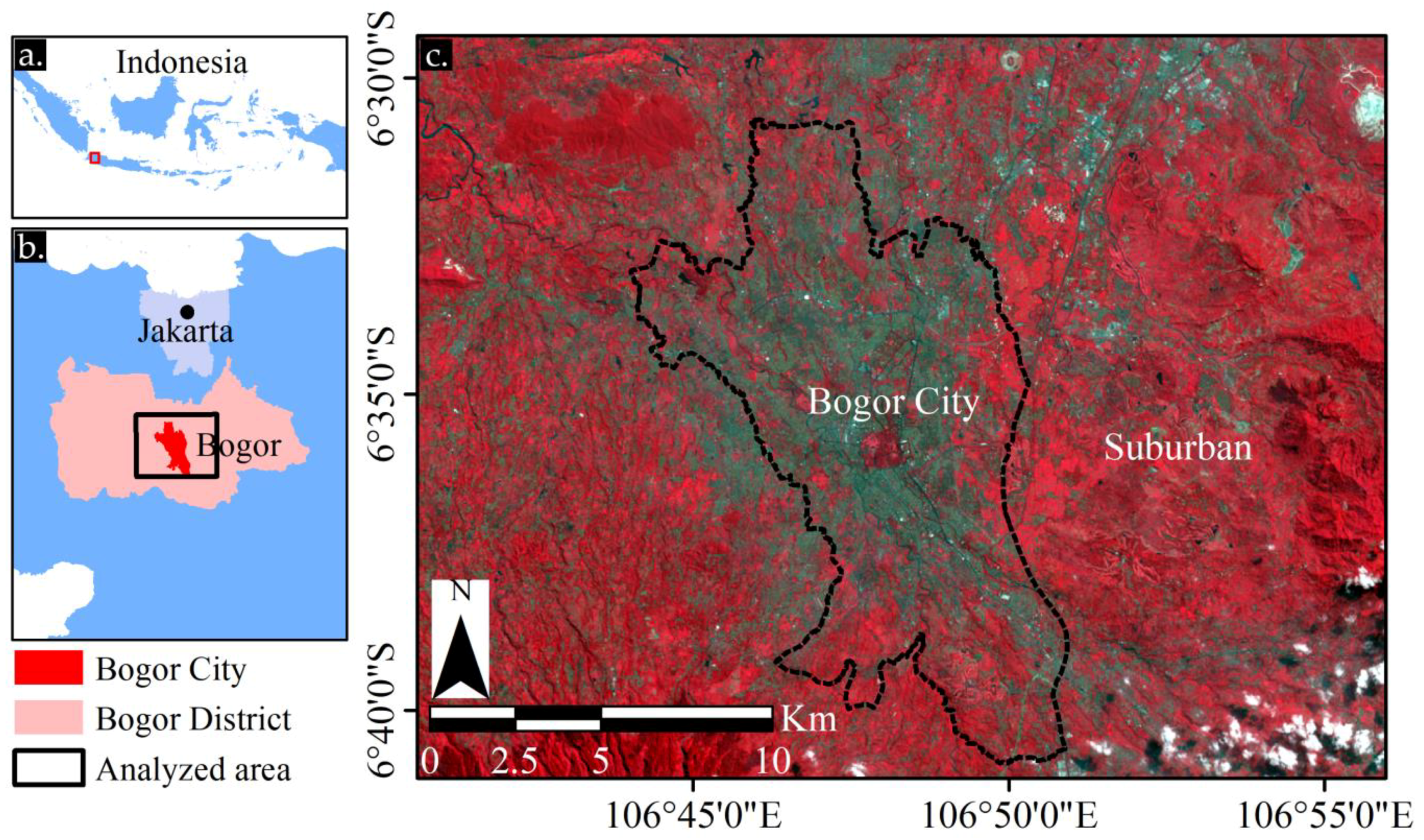



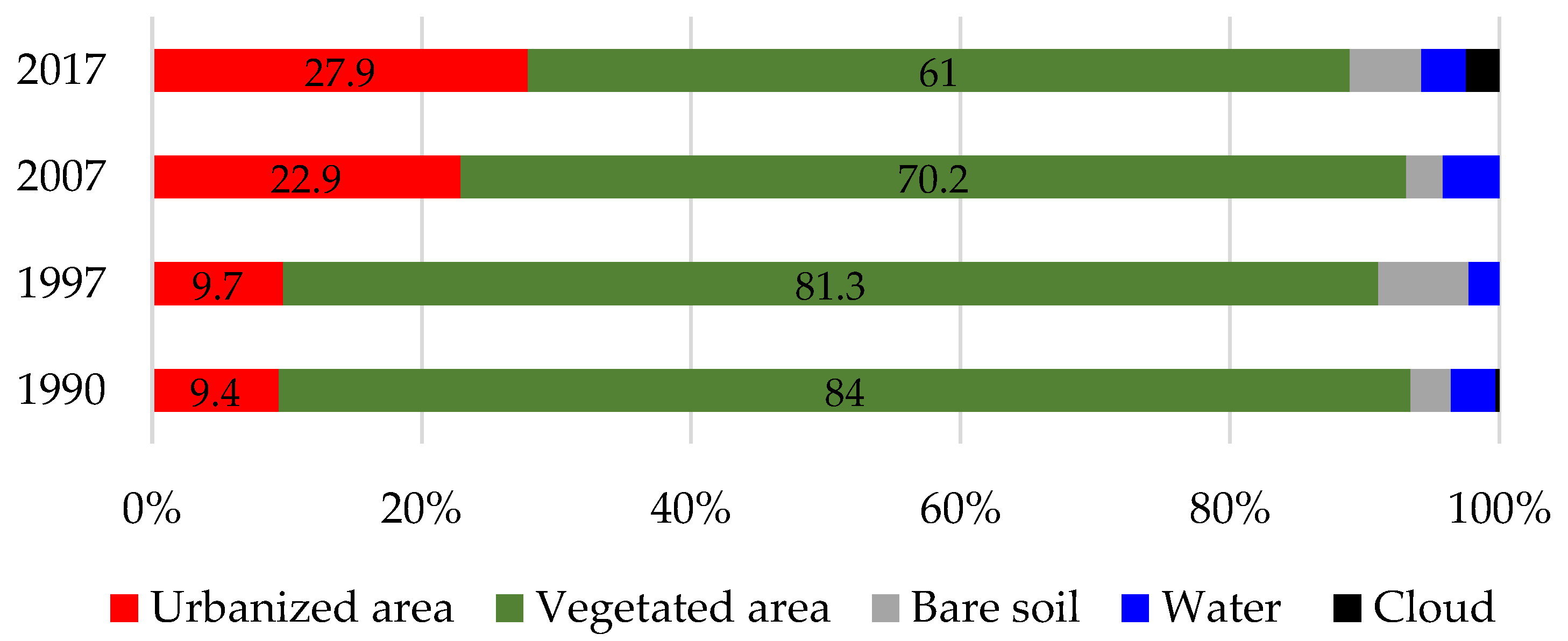
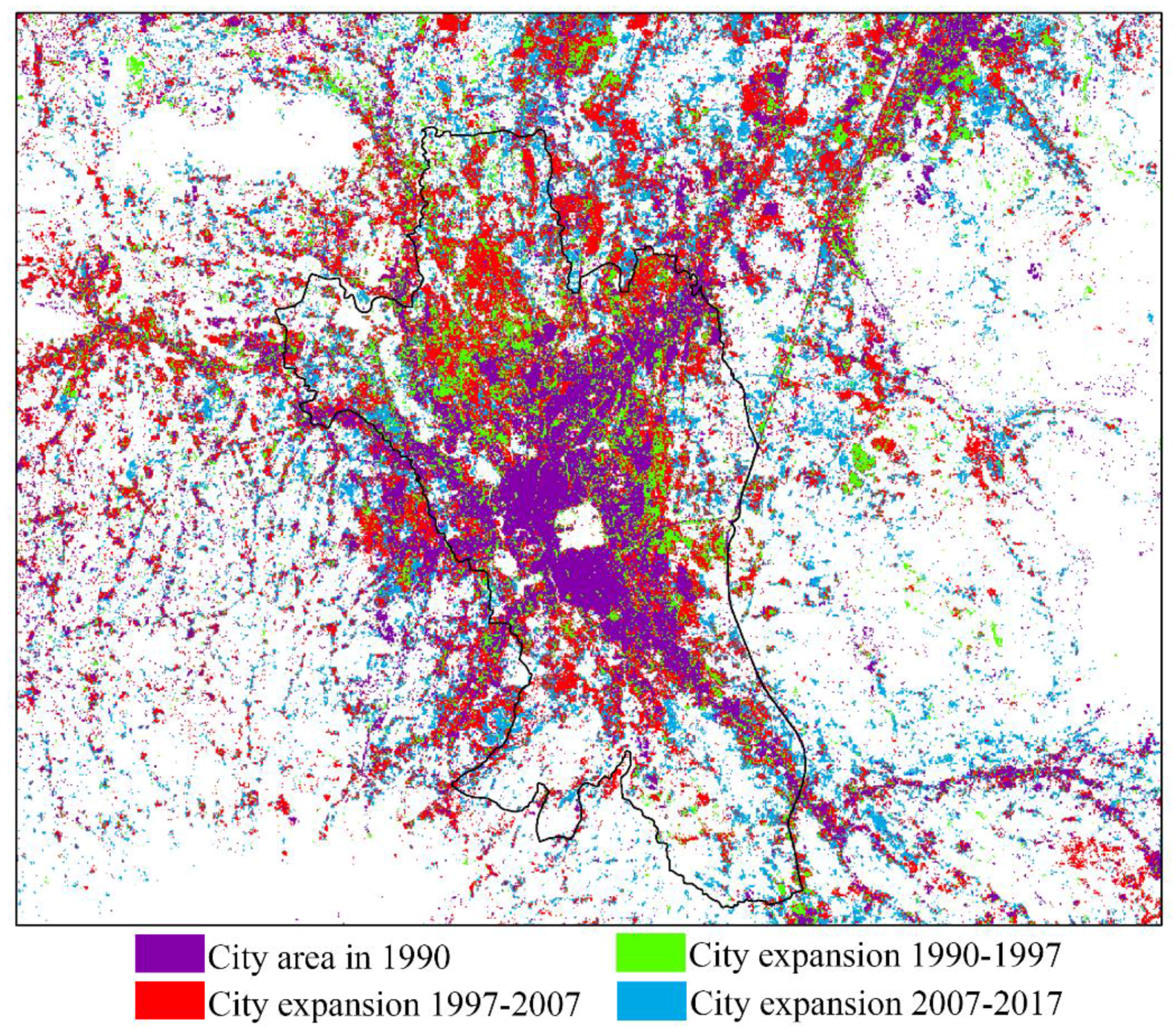
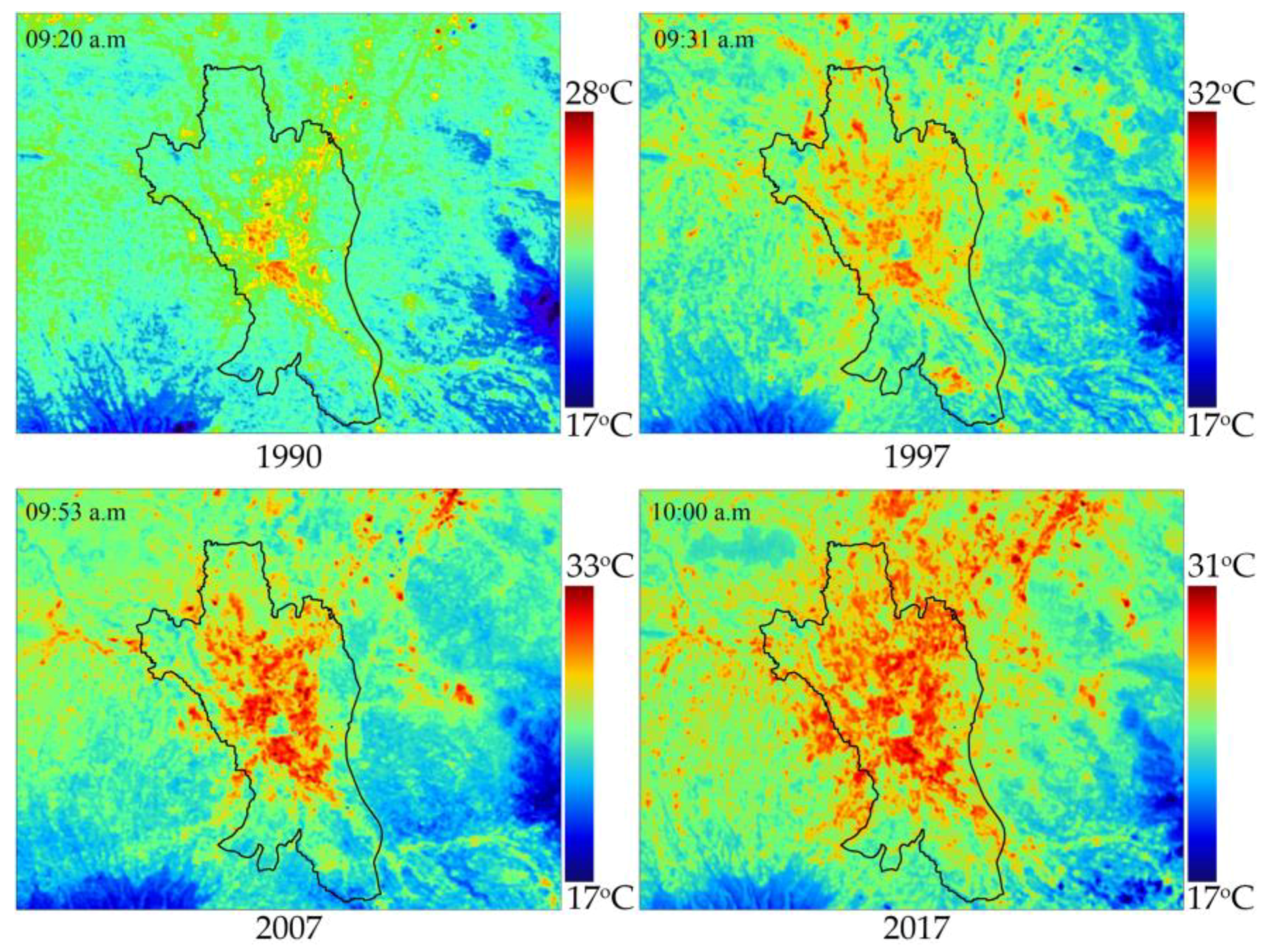

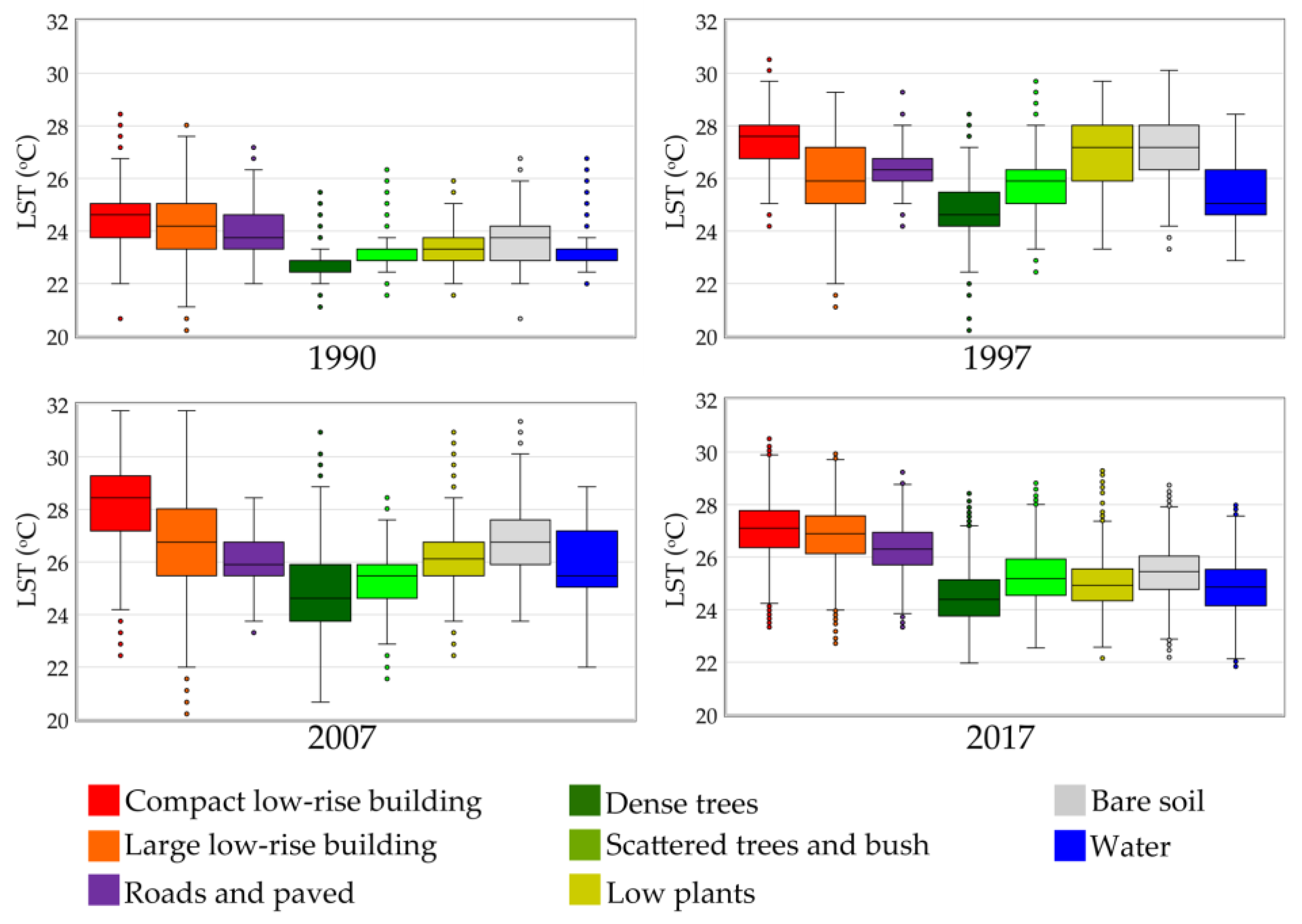
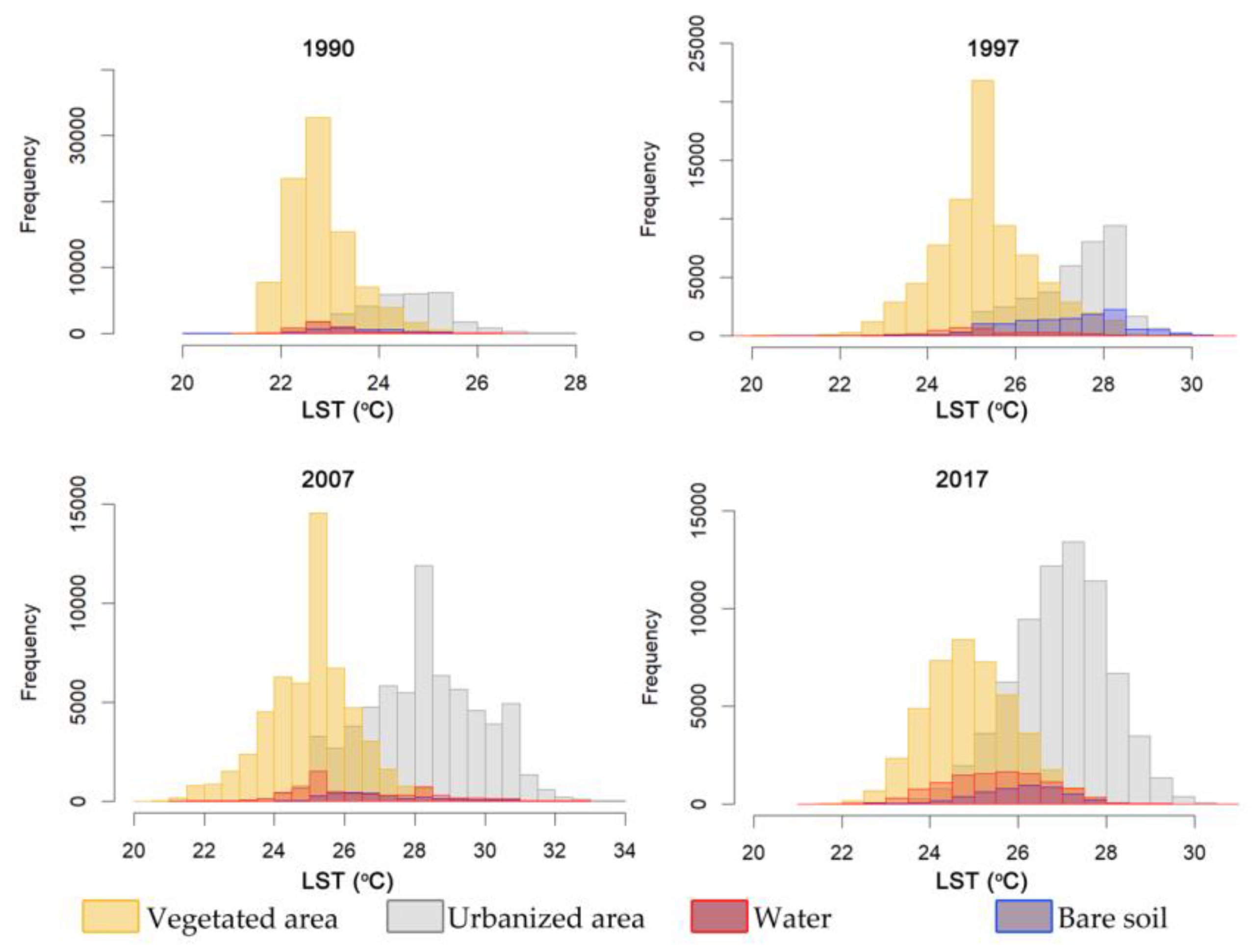
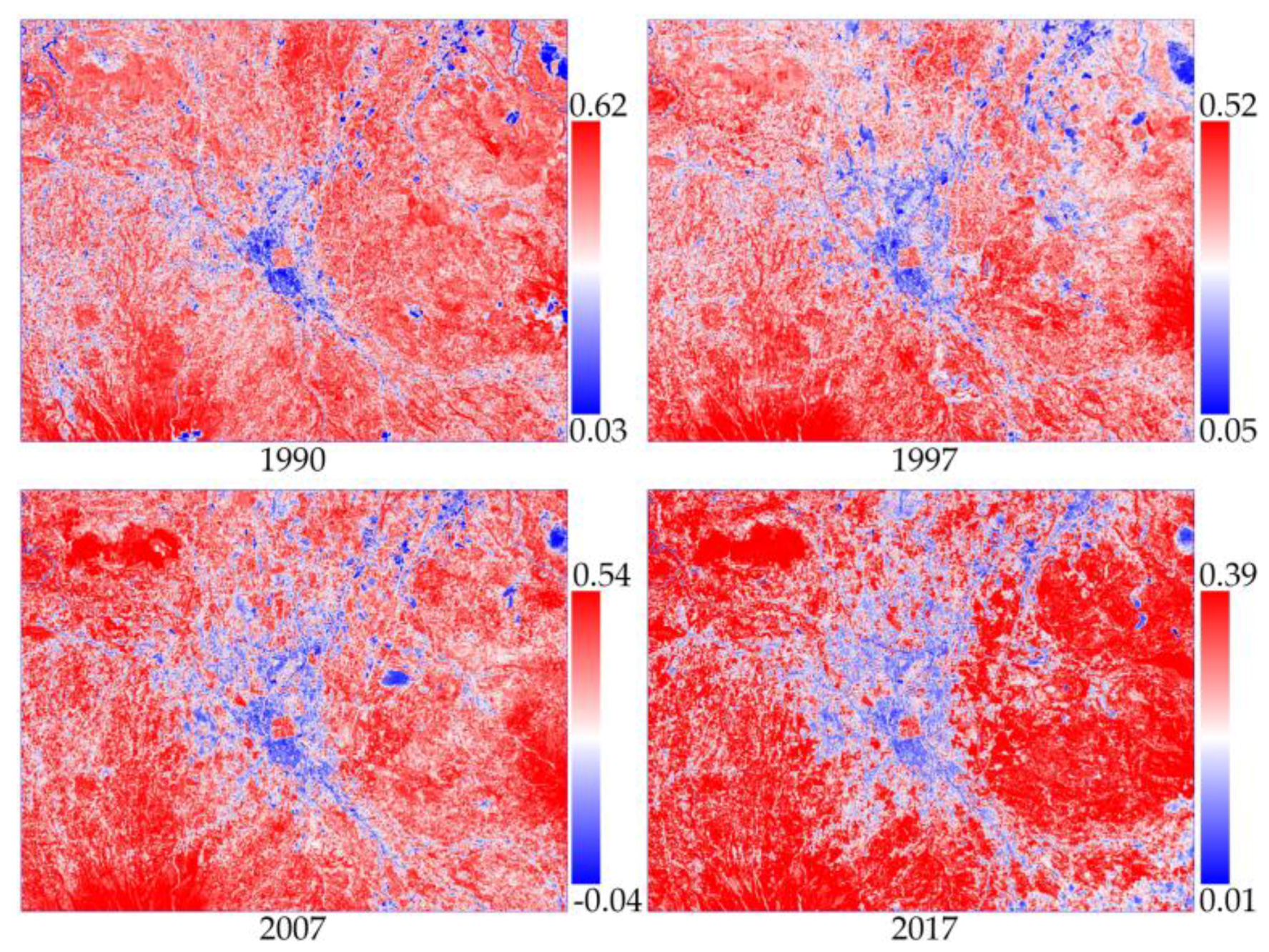
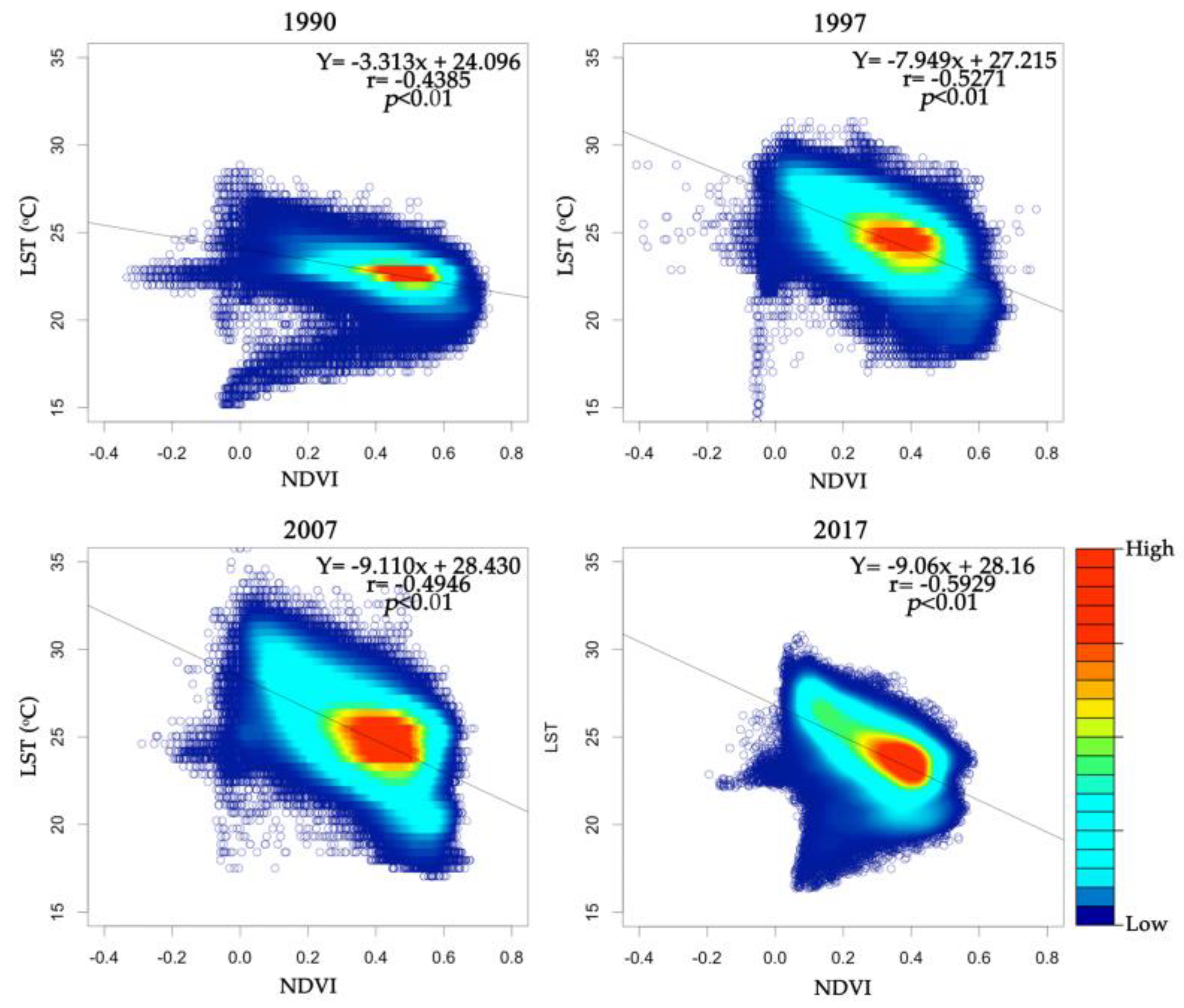

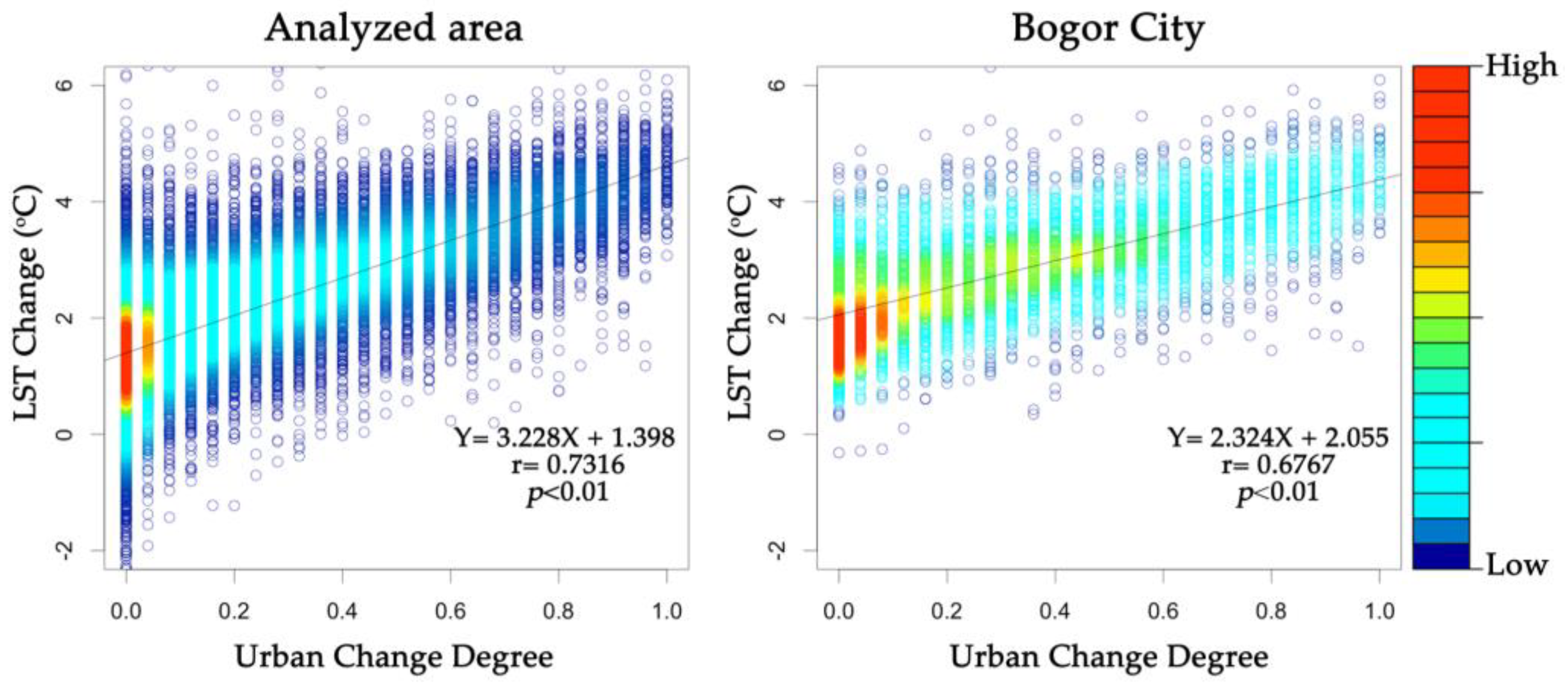
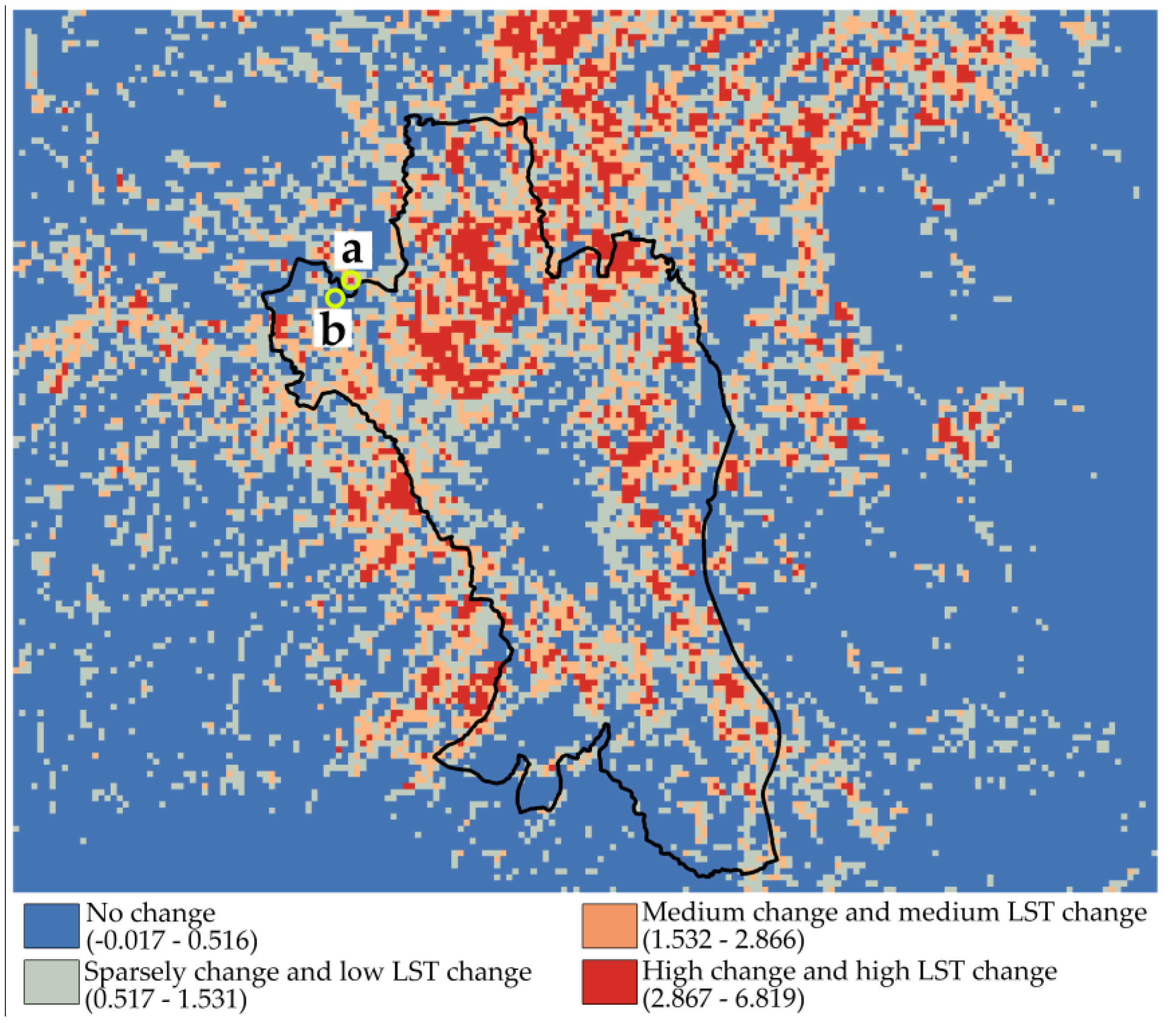
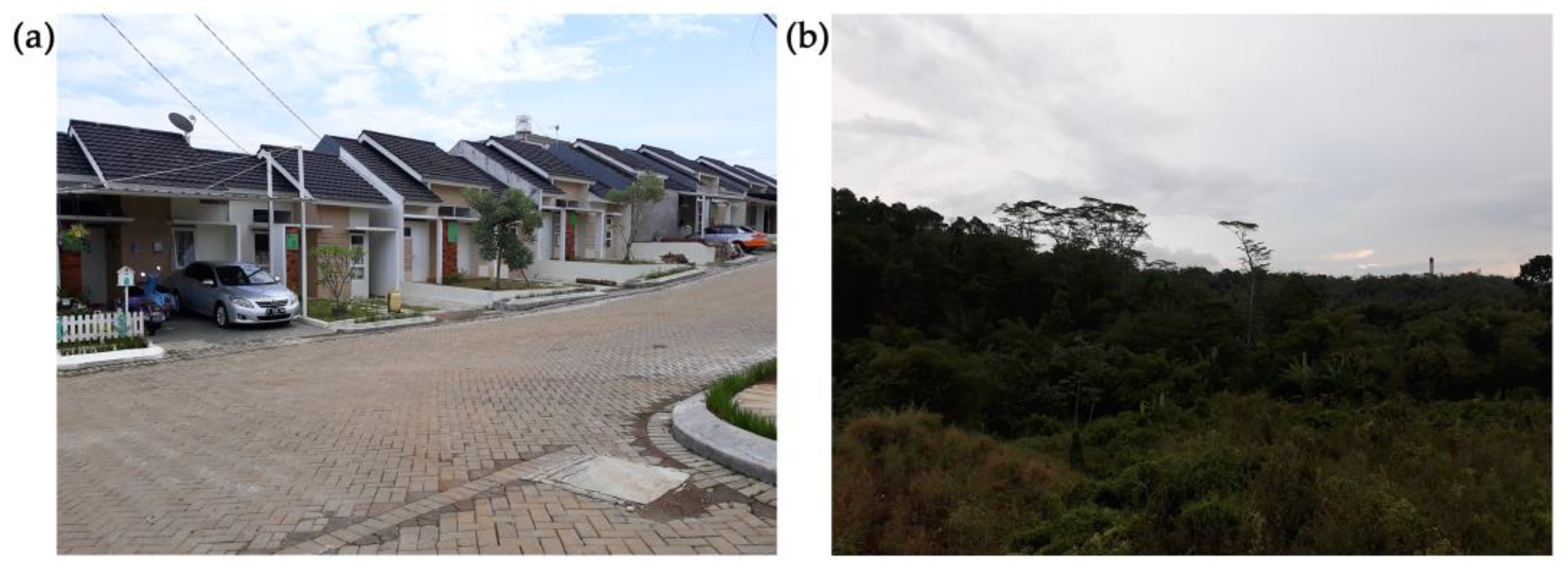
| Image Acquisition Date | Sensor | Bands for LCZ Classification | Thermal Band |
|---|---|---|---|
| 9 July 1990 | Landsat 5 TM | 1–5, & 7 | 6 |
| 28 July 1997 | Landsat 5 TM | 1–5, & 7 | 6 |
| 26 September 2007 | Landsat 5 TM | 1–5, & 7 | 6 |
| 19 July 2017 | Landsat 8 OLI/TIRS | 1–7 | 10 |
| Year | 1990 | 1997 | 2007 | 2017 |
|---|---|---|---|---|
| Accuracy (%) | 92.54% | 88.62% | 85.09% | 85.88% |
| Year | Overall Accuracy (%) | Kappa Coefficient |
|---|---|---|
| 1990 | 95.02 | 0.83 |
| 1997 | 90.68 | 0.78 |
| 2007 | 93.29 | 0.87 |
| 2017 | 98.94 | 0.97 |
| LCZ Types | 1990 | 1997 | 2007 | 2017 |
|---|---|---|---|---|
| Urbanized area * | 5846.9 | 6058.6 | 14272.3 | 17404.8 |
| Vegetated area | 52337.5 | 50681.8 | 43771.3 | 37988.5 |
| Bare soil | 1881.5 | 4160.7 | 1649.5 | 3286.0 |
| Water | 2068.3 | 1421.4 | 2629.4 | 2065.1 |
| Cloud | 188.3 | 0.0 | 0.0 | 1578.2 |
| 2017 | |||||||||||||
|---|---|---|---|---|---|---|---|---|---|---|---|---|---|
| Urbanized Area | Vegetated Area | ||||||||||||
| 1 | 2 | 3 | 4 | 5 | 6 | 7 | 8 | 9 | Total | ||||
| 1990 | Urbanized area | 1. Compact low-rise building | 4.4 | 0.5 | 0.1 | 0.1 | 0.4 | 0.2 | 0.2 | 0.1 | 0.1 | 6.2 |  |
| 2. Large low-rise building | 0.3 | 0.2 | 0.0 | 0.1 | 0.2 | 0.1 | 0.1 | 0.0 | 0.5 | 1.5 | |||
| 3. Roads and paved | 0.9 | 0.1 | 0.1 | 0.1 | 0.2 | 0.1 | 0.1 | 0.1 | 0.0 | 1.7 | |||
| Vegetated area | 4. Dense trees | 12.2 | 1.2 | 0.7 | 17.9 | 13.4 | 7.8 | 2.6 | 1.8 | 1.4 | 58.9 |  | |
| 5. Scattered trees and bush | 3.9 | 0.7 | 0.3 | 4.1 | 6.2 | 4.2 | 1.5 | 0.6 | 0.4 | 21.8 | |||
| 6. Low plants | 0.4 | 0.1 | 0.0 | 0.8 | 0.9 | 0.8 | 0.3 | 0.1 | 0.0 | 3.3 | |||
| 7. Bare soil | 0.8 | 0.1 | 0.0 | 0.3 | 0.8 | 0.4 | 0.4 | 0.0 | 0.1 | 3.0 | |||
| 8. Water | 0.6 | 0.1 | 0.1 | 0.3 | 0.9 | 0.4 | 0.2 | 0.6 | 0.0 | 3.3 | |||
| 9. Cloud | 0.0 | 0.0 | 0.0 | 0.3 | 0.0 | 0.0 | 0.0 | 0.0 | 0.0 | 0.3 | |||
| Total | 23.6 | 3.0 | 1.4 | 23.9 | 23.0 | 14.1 | 5.3 | 3.3 | 2.5 | 100.0 | |||
 |  | ||||||||||||
© 2018 by the authors. Licensee MDPI, Basel, Switzerland. This article is an open access article distributed under the terms and conditions of the Creative Commons Attribution (CC BY) license (http://creativecommons.org/licenses/by/4.0/).
Share and Cite
Nurwanda, A.; Honjo, T. Analysis of Land Use Change and Expansion of Surface Urban Heat Island in Bogor City by Remote Sensing. ISPRS Int. J. Geo-Inf. 2018, 7, 165. https://doi.org/10.3390/ijgi7050165
Nurwanda A, Honjo T. Analysis of Land Use Change and Expansion of Surface Urban Heat Island in Bogor City by Remote Sensing. ISPRS International Journal of Geo-Information. 2018; 7(5):165. https://doi.org/10.3390/ijgi7050165
Chicago/Turabian StyleNurwanda, Atik, and Tsuyoshi Honjo. 2018. "Analysis of Land Use Change and Expansion of Surface Urban Heat Island in Bogor City by Remote Sensing" ISPRS International Journal of Geo-Information 7, no. 5: 165. https://doi.org/10.3390/ijgi7050165
APA StyleNurwanda, A., & Honjo, T. (2018). Analysis of Land Use Change and Expansion of Surface Urban Heat Island in Bogor City by Remote Sensing. ISPRS International Journal of Geo-Information, 7(5), 165. https://doi.org/10.3390/ijgi7050165




